Introduction
If you are a crypto player, you have probably heard of the myths of Pump.fun and Polymarket.
In the past few months, from $PEPE to $DOGWIFHAT, to $BODEN to $MOTHER, memecoin has dominated almost every corner of crypto. The Memecoin craze has brought millions of dollars in profits to early participants and decentralized exchanges such as Raydium.
The wealth effect brought by Memecoin has also driven Solana's daily active users to grow 18.7 times since the beginning of the year (Source: Tokenterminal). Among them, Pump.fun is particularly noteworthy. It took advantage of this craze to create an easy-to-start, no-programming memecoin platform, and generated nearly $100 million in revenue through a 1% transaction fee and a 2 SOL startup fee. Considering the low technical barriers and development work required, this is a very profitable business. (*The 2 SOL startup fee was recently cancelled to increase usage)

Source: @adam_tehc dune-dashboard
At the same time, another popular platform based on Polygon, Polymarket, has gained significant attention and trading volume as the US election approaches. Currently, there are more than $100 million in active bets (open contracts) and 7-8 thousand daily active wallets on the platform.
In addition to the election, the platform's increased attention has also promoted the growth of trading volume in non-election events, such as pop culture, scientific topics such as "monkeypox", etc. For example, the topic of "Most Gold Medals in the Paris Olympics" attracted more than $7.8 million in bets. Polymarket does not charge any fees, so its revenue cannot be reflected in the data.
Without an incentive program, both products have shown significant organic growth in user attention and trading volume, which is rare in the current crypto market. They are succeeding not only because they fit the current narrative, but also because they excel in three key aspects of being Web3 consumer applications:
Financial elements
Social elements
Seasonal drivers
Today, we’ll dive into the cases of Polymarket and Pump.fun, and the lessons that Web3 consumer applications can learn from them to achieve organic growth without relying on points incentives.

1. Reason 1: Right Time
Polymarket:
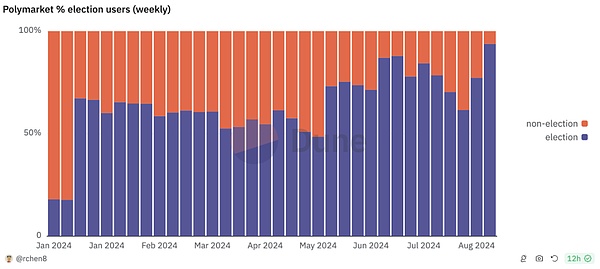
Source: @rchen8 dune-dashboard
It is well known that elections have been the main driving force behind Polymarket's growth.
In May 2023, Polymarket became popular due to the fact that there were more than 60 markets on the Titan Submersible. Since June 2024, trading volume on Polymarket for politically related events has increased from about $110 million to $330 million. Topics are mainly related to Biden's resignation, Trump debates, and other election-related issues.
According to @richardchen39 of 1confirmation, more than 94% of Polymarket's current trading volume is election-related, while less than 6% is related to sports and macro market prediction topics, such as "August Fed Rate" or "Which country will win the most Olympic medals?"
So far, there is no doubt that the election is the main catalyst behind the "Mass adoption" story. Given that the growth in trading volume is mainly driven by strong seasonal factors, post-election trading volume is also something to watch for the platform.
Pump.fun:
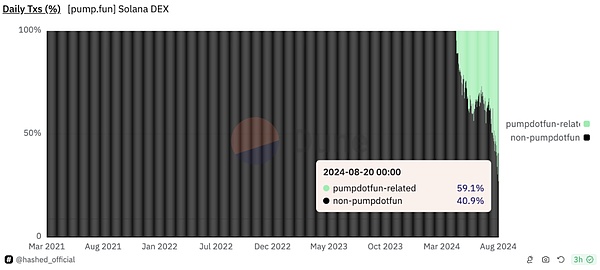
Source: @hashed_officail dune-dashboard
The craze for memecoins like $wif and $bonk inspired the creation of Pump.fun, a memecoin launcher that allows tens of thousands of users to easily create tokens in seconds at almost zero cost.
The platform became popular for spawning multiple viral memecoins, including celebrity coins like $DADDY and $MOTHER, or animal coins like $MICHI and $BILLY. This created a "gold rush" trend, with users constantly trying to create the next 100x token. The platform has profited greatly from this activity by charging a 1% fee on every trade, generating nearly $100 million in revenue.
Pump.fun’s influence can be observed through the dominance of its associated tokens on decentralized exchanges, which currently account for about 60% of trading volume. However, while the easy issuance of tokens is beneficial to users, it also attracts bad actors. According to Protos.com, only 41 out of 1.7 million memecoins have reached and maintained a high market cap, meaning the chance of "success" is close to 0.00002%.

2. Reason 2: Crypto is an attention economy
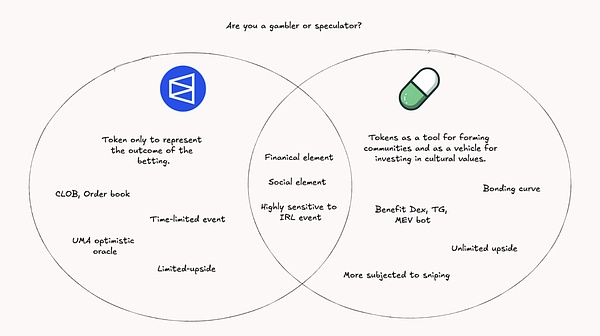
Source: IOSG
Polymarket and Pump.fun are completely different platforms that serve different purposes.
Polymarket is a platform that allows users to speculate on the outcomes of real-life events by placing bets. In contrast, Pump.fun is a token launcher that allows any user to "tokenize" anything for a variety of purposes, including gambling on various real-life events, various memes, and various attention economies.
What they have in common is that they are both highly sensitive to real-life events. "The best example is the positive correlation between election-based prediction market trading volume and the number of election-based tokens minted on Pump.fun."
This is a very powerful advantage for both platforms because major real-world events (such as Trump's shooting) can attract the limited attention and engagement resources of Web2 and Web3 audiences. These headlines on Google or any media can attract millions or even trillions of impressions for a topic. Polymarket and Pump.fun have successfully converted this attention into a market where people can invest capital to express their opinions and make money from it.
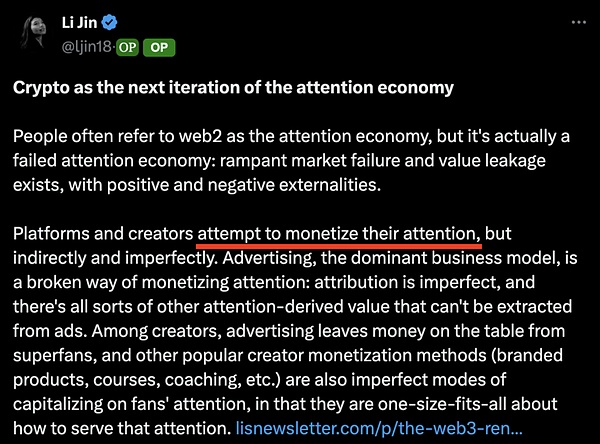
Source: Li Jin, twitter
This is a new attention economy market paradigm driven by Web3 technology in the form of "tokenization", and a P2P platform where bets can be made anonymously and transparently. The demand is super strong, and no platform needs a points plan to guide users.
On the other hand, real-time odds are one of the reasons why Polymarket provides great statistical value to Web2. According to SimilarWeb.com, Polymarket's total website visits are 9 million, close to the total visits of platforms such as Telegram and Notion.
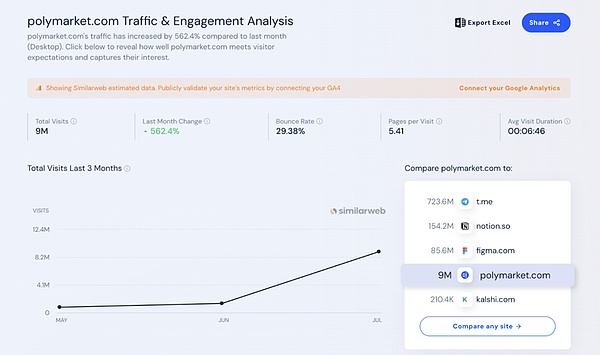
Source: SimilarWeb.com
These statistics show that users use Polymarket not only to gamble, but also to observe more accurate directions and odds of major events, a statement also supported by Dune Analytics:
"When money is at stake, decisions are often more radical and immediate than those made based on ideological beliefs in order to control losses or seize opportunities."
So far, 85% of the initialization issues on Polymarket have been resolved, and 15% are still awaiting results. Polymarket resolves time-limited events by leveraging the UMA optimistic oracle, a system in which proposers can propose answers and stake assets to obtain market results. In contrast, Pump.fun does not have a direct resolution mechanism, and the predicted results can only be reflected indirectly from the corresponding token prices. For example, $boden fell 95% after the news of Boden's ouster. Therefore, compared to Polymarket, Pump.fun provides limited statistical value and mainly serves as a rough indicator of the popularity of an event.
That being said, Pump.fun is still a great platform for creators to monetize attention and influence. Anyone, including celebrities, crypto users can build a larger community based on token price speculation and personal branding.

3. Reason 3: Three successful candles
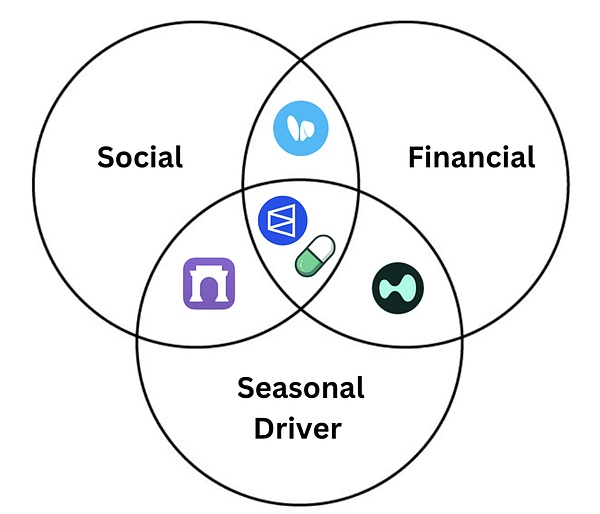
Source: IOSG
3.1 Financial elements - the first candle
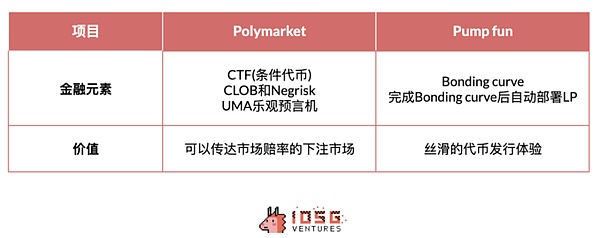
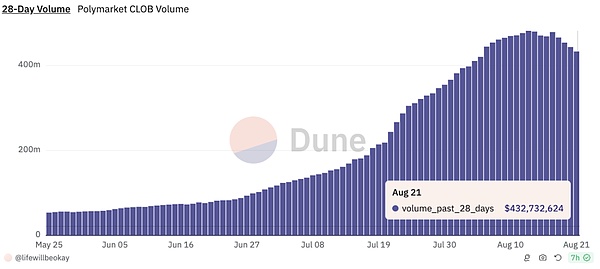
Source: @lifewillbeokay dune-dashboard
Blockchain is a highly finance-driven industry and technology.
Every popular project has a very strong financial element, and the "product" born from these elements needs to have a certain value. Value comes in the form of yield, security, transparency, data or decentralization, which users can't find anywhere else except your product. Unlike traditional gambling applications that must comply with regulations and compliance requirements (betting on elections is illegal), platforms like Polymarket and Pump.fun allow users to remain anonymous while speculating on real-world events.
Polymarket, with its CLOB (Central Limit Order Book), Negwisk, and benefiting from the transparency brought by using Gnosis's CTF, provides the most unique and attractive financial tools for betting on any important topic in real life or crypto. Users can deposit USDC and bet on anything they think they can win, adding a "financial" layer to all real-life events.
At the time of writing, Polymarket has organically generated more than $432 million in trading volume through its CLOB in the past 28 days, comparable to SushiSwap's $535 million in trading volume. On the other hand, Pump.fun's financial elements include pre-built bonding curves for "fair launches" and automatic deployment of liquidity pools (LPs) after the curve is filled. The platform not only provides non-technical creators with the tools they need to "tokenize" their influence or attention, but also provides seamless transactions, making the issuance of tokens more efficient.
In addition, tokens issued on the platform also represent a "financial element" because they embody cultural values, opinions, or any topic that attracts attention. The token trading activity generated by Pump.fun also benefits related parties, such as network activity, DEX trading volume, Telegram bot, and MEV. One example is Jito stakers, who can receive up to $624,000 in MEV rewards per day due to increased network activity.

Source: @ilemi dune-dashboard
3.2 Social Elements - Second Candle
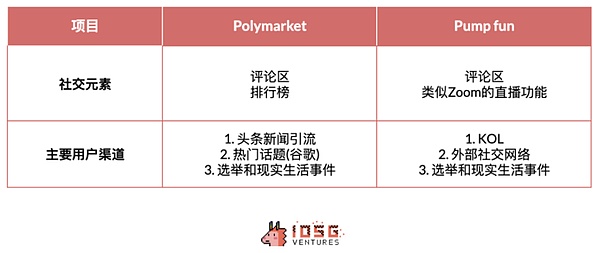
Source: IOSG
Now with a financial component, Polymarket and Pump.fun began embedding social features into their products in an attempt to retain users while creating the network effects they needed to grow their projects.
As Polymarket grew, it became clear that the social elements within the app had grown significantly. In their product, under each individual market, there are community related features such as comment areas where users can express their opinions on the bets.
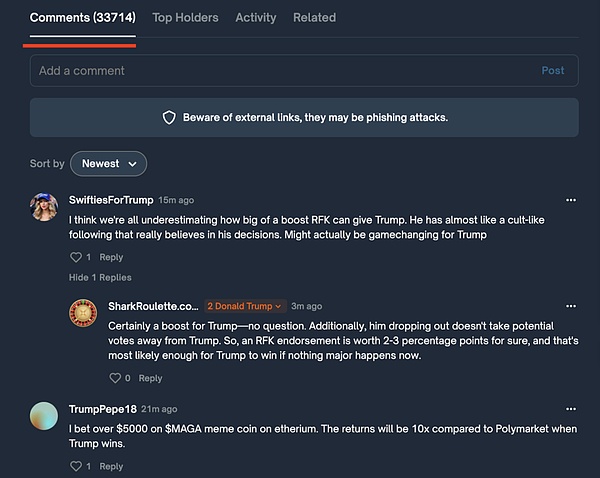
Source: Polymarket
Take the most popular topic "2024 Presidential Election Winner" as an example, there are more than 33,700 comments under this topic. This is important because it not only increases community engagement on Polymarket, but also attracts new users to join the conversation.
In the past seven days, stickiness looks very strong, with an average return visit rate of 60-70%.
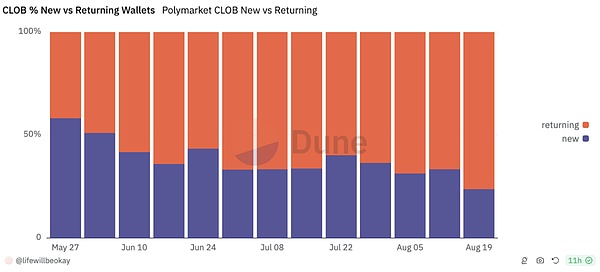
Source: @lifewillbeany
In addition to the comment section, the percentage of the topic is often used as headlines in different media about election-related news, which in turn attracts more users to join the platform. In the last month alone, Polymarket attracted 65,000 new users, and growth is expected to continue as more markets for headlines emerge and attention to the election increases.
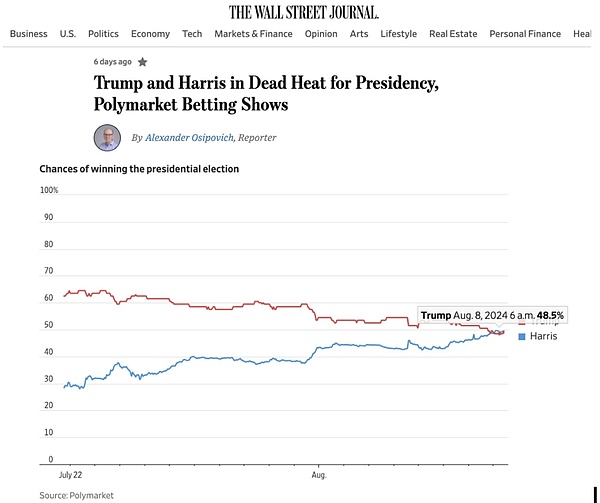
Source: The Walls Street Journal
On the other hand, Pump.fun has been integrating various social media elements, aiming to increase product engagement by building the platform into a place where users can connect and communicate, rather than just a token launcher. However, since Pump.fun announced the live broadcast feature on May 29, their DAU has not improved significantly, stabilizing at around 50,000-60,000 DAU, with 20,000 new accounts, and no substantial growth has been observed in a few months.
On August 23, Pump.fun announced the screen sharing feature on the app and a multi-screen feature for a live broadcast room. Despite the slow growth in new user acquisition trends, the intention to build more in-app social features on the platform has been clear, as the team understands that these features are needed to stir up more excitement around their product. In addition to live streaming, the frequency of tokens listed on Raydium also acts as a channel to attract new users to Pump.fun, as more and more users recognize this wealth effect that Pump.fun brings to creators.
In short, the social element is one of the main factors driving the attention economy of Polymarket and Pump.fun, which is supported by the functional financial engine of the product, and growth can be sustained through the network effect established by the participating community.
3.3 Seasonal Drivers - The Third Candle
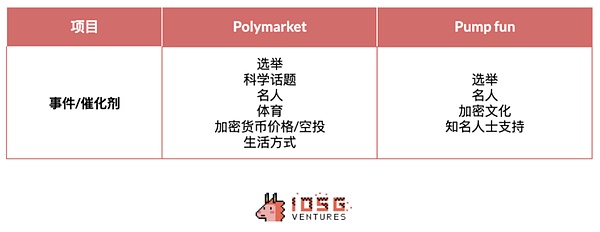
Source: IOSG
Finally, seasonal drivers play an important role in increasing the visibility of these products and helping the products reach PMF. As I mentioned above, both products are highly sensitive to real-life events, especially in terms of celebrities, elections, and cultural events, which are "speculative". For example, Polymarket has managed to gain a lot of attention from different channels due to the upcoming US election. At the same time, the popularity and trading volume of non-election betting markets have also seen a surge, despite the current limited market share.

Source: Presto Research
It has also been observed that the market has been actively creating and betting on topics that are hot in Google searches. For example, Google searches for Mpox disease surged by 120%, creating $950,000 worth of Mpox-related event bets. This reflects that seasonal drivers have helped Polymarket "fit in" with the betting culture while bringing the product to the masses.
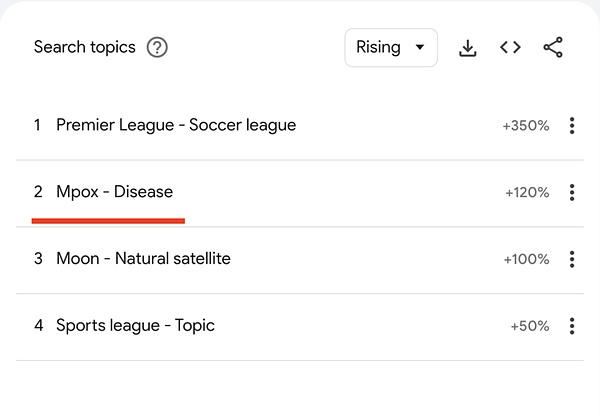
Source: Google Trend
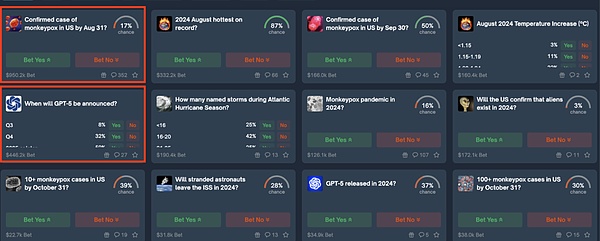
Source: Polymarket
Similarly, Pump.fun also gained huge benefits from a series of real-life events. For example, Elon Musk and Donald Trump’s Twitter Space created more than 10,000 tokens in 3 hours and generated more than $500,000 in revenue on the same day.
Although there is a positive correlation between real-life events and Pump.fun activities, we cannot ignore that Pump.fun’s success is also highly dependent on the rise of memecoin culture, such as celebrity coins $daddy and $mother. This trend has been supported and promoted by well-known figures in the industry, including @weremeow and Ansem, which has greatly increased the popularity of Pump.fun. Between April and August, the number of token deployments showed a clear upward trend, increasing 5 times from 300,000 to 1.6 million.
With the financial component and social elements within the product, seasonal drivers lit the last candle and pushed the product to unprecedented growth.
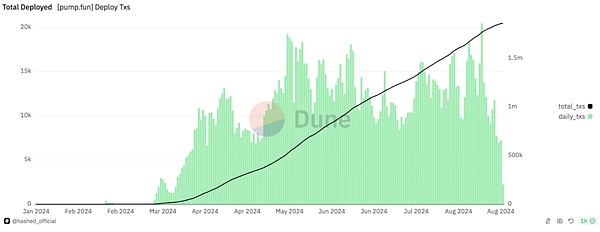
Source: hashed_offical, dunedashboard

4. Conclusion
For each protocol to remain competitive in this space, they must meet three basic elements (three candles):
The financial element provides the protocol with the "value" it needs to start participating in the economy and keep users sticking to the system. The social element improves user stickiness on the basis of the existing financial elements and creates a community that constantly attracts new users. Seasonal drivers drive continued growth for protocols that already excel in social and financial elements.
From the experience of Pump Fun and Polymarket, we learned that any consumer application in Web3 should first build a strong financial element that enables users to profit or gain intrinsic value. Then, combined with built-in network effects, encourage active user participation and attract new users through additional channels. Tokens are an effective tool to bootstrap this network effect in the early stages. Finally, attract the attention of the Web2 community through seasonal drivers to increase adoption and usage.
That being said, given the lack of new hot spots at the application layer, the current crypto market is more PvP-dominated than ever, with most activities driven by incentives or speculation. Users have too many similar choices on different chains, and protocols try to replicate the success of existing cases and fail to bring novel ideas.
To break this repetitive PvP cycle, the next unicorn company must stand out from innovation at the product level, solve real user problems, and naturally trigger widespread user adoption as seasonal drivers arrive.
 JinseFinance
JinseFinance
 JinseFinance
JinseFinance JinseFinance
JinseFinance JinseFinance
JinseFinance JinseFinance
JinseFinance JinseFinance
JinseFinance JinseFinance
JinseFinance JinseFinance
JinseFinance JinseFinance
JinseFinance JinseFinance
JinseFinance Bitcoinist
Bitcoinist